What Can I Use to Roll Out My Muscles
Using a foam roller is a tried and tested method to perform some basic self-myofascial release sequence to restore range of motion. However, what happens if you don't have a foam roller handy? How to roll out sore muscles without a roller?
Generally, if you don't have a roller you can roll out sore muscles using alternative tools like massage ball, kettlebell, bamboo tube, PVS pipe, dough roller, peanut ball, lacrosse ball, or even the medicine ball. The rolling surface will depend on the size and the diameter of the tools you're using.
So is having a professional foam roller the only way to reduce muscle tension? Not at all.
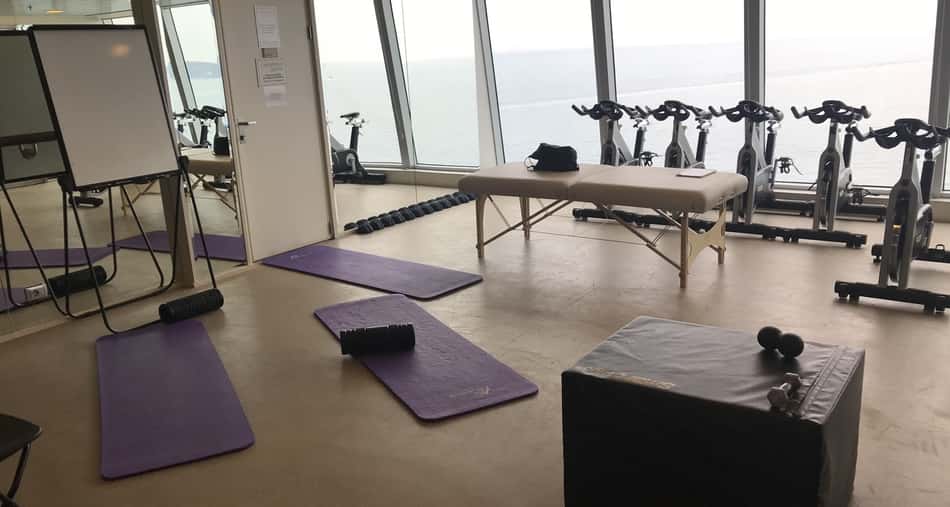
There are multiple alternatives you probably own right now that can temporarily replace a foam roller. And the only limitation is your own creativity.
In this article, I will share with you some basic tools you can use as a foam rolling alternative, explain which muscles they can be used for, which cannot, and teach you what to do instead of foam rolling.
Mobilize with Kettlebell
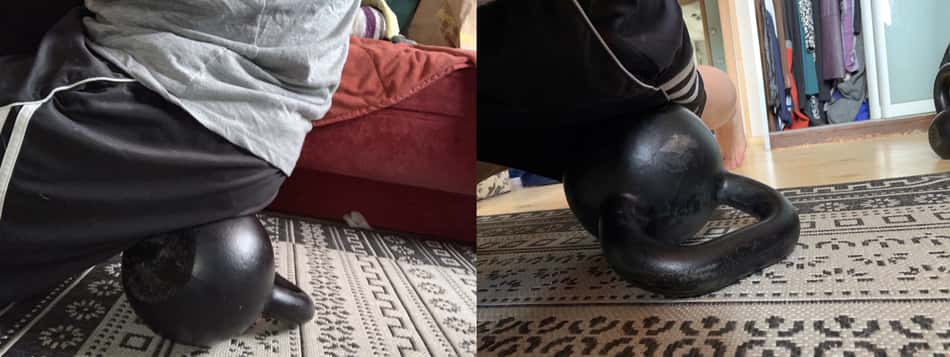
A good gym will typically have more kettlebells than foam rollers. And if that's the case, you can use that amazing tool in two different ways to reap the rewards of self-myofascial release. You can either lay down facing down on the kettlebell in a way that you position the KB under your targeted muscle.
Or you simply place the kettlebell on the muscle that you want to mobilize. Either way will work. Bear in mind that most of the kettlebells are made of iron steel and the pressure will feel much different, comparing to the plastic foam roller.
Tips for placing the Kettlebell on your muscle
- When you place a kettlebell on your legs, instead of "rolling", use the contract-relax technique. Contract relax means you create a peak squeeze in the muscles that you want to mobilize for 5 seconds, followed by 10 seconds of relaxing time (all while having a kettlebell on your muscle).
- You can repeat this cycle 5 times and then reposition the kettlebell from a different angle of the same muscle.
- If you mobilize quads, then start from being close to the knee and slowly inch by inch move up towards your hip.
- Contract-relax is a technique borrowed from PNF, and it will help you to fatigue the muscle tissue faster and release the tensions than a regular rolling back and forth. In fact, if you feel pain during the foam rolling, this technique is perfect to desensitize the tissue. So the rolling doesn't feel such a drag.
Tips for having the Kettlebell under your muscle
- Place the kettlebell with the handle resting on the floor. This will provide you with better stability.
- Because of the form of the kettlebell, you don't want to "roll" on it. Use the same technique contract-relax and stay on one spot for longer.
- Another great way to get the most bang out of the buck is to add simple flexion and extension. So if you mobilize your quads, spend few seconds doing contract-relax and add simple flexion of your knee.
- This will allow you to get into those hidden corners and smoke out all of the muscle tension.
Related article: Foam Rolling: Why it hurts & How to make it less painful
Spend some time with a Barbell
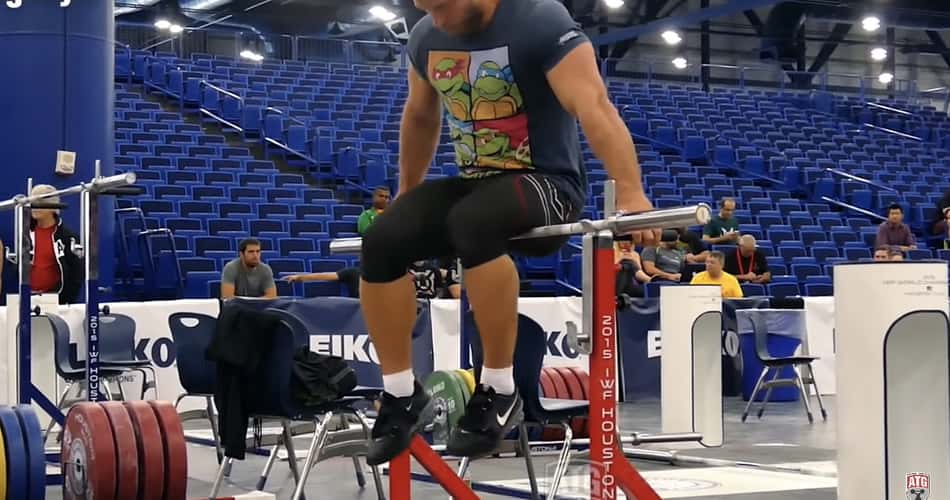
A classic alternative for a foam rolling is a barbell. Similarly to the kettlebell, you can use it in two different ways where you either place the sleeve of the barbell (the thick part where you typically load up the plates) on your muscles, or you lay down on the barbell to smash your glutes, quads or hip flexors.
It works like a charm and it doesn't take long to really feel the knots letting go.
Tips for placing the barbel on your legs
- Be mindful of the weight. With a heavier load, you will more likely will more pressure.
- If you don't have enough pressure, feel free to lean forward and press on the barbell.
- You could roll the sleeve back and forth, however for best results use the contract-relax method,
Tips for laying down or sitting on the barbel
- If you sit on the barbell, make sure it fits comfortably and is stable
- If you're doing it in the squat rack, make sure you're not in a way of other people
- If you're laying down, use contract-relax and flex-extend method
Use a dough roller or pizza roller
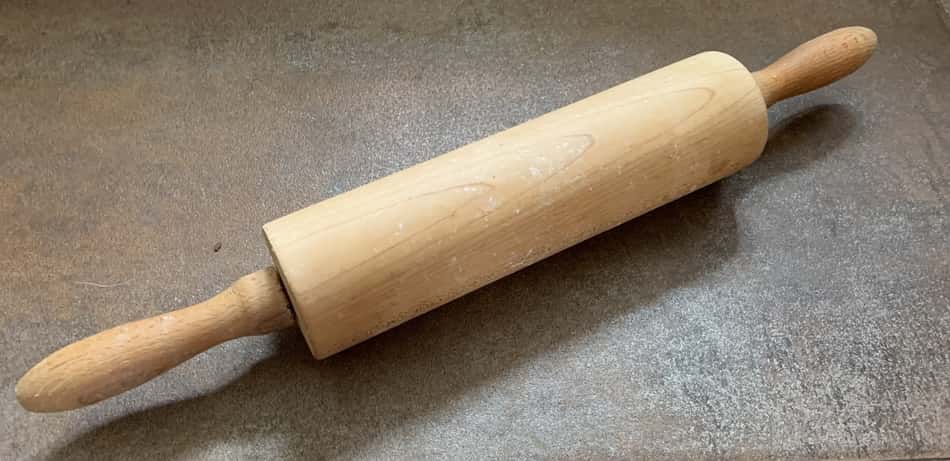
One of the most basic pieces of kitchen equipment in most people's homes that could replace foam roller is a dough roller. You can use a simple kitchen dough or pizza roller as an alternative.
Dough rollers are usually made of hard plastic or wood, with a polished finish so there are no sharp edges that can hurt or cut your skin. They are also quite solid and durable so they can easily maintain the pressure without you breaking them down. They are easy to roll on as they are perfectly symmetric.
One thing to notice about dough rollers is that they have a small diameter, way smaller than a regular foam roller. This means you can feel more pressure. With a smaller diameter, the center of the pressure on the muscle is more local, comparing to regular foam roller.
Tips for rolling with the dough roller
- Find a spot where you can place a towel or the yoga mat
- Clean up the dough roller before from any flower to not stain your clothes
- Use clothes that are tight and close to the skin because, during the rolling, the wood can wrap the material underneath and made you adjust yourself several times.
Because a dough roller is much smaller than a regular foam roller, instead of doing regular rolling where you just roll up and down, you can apply different techniques like contract-relax and flexion-extension, while being on the roller.
Level up to the medicine ball
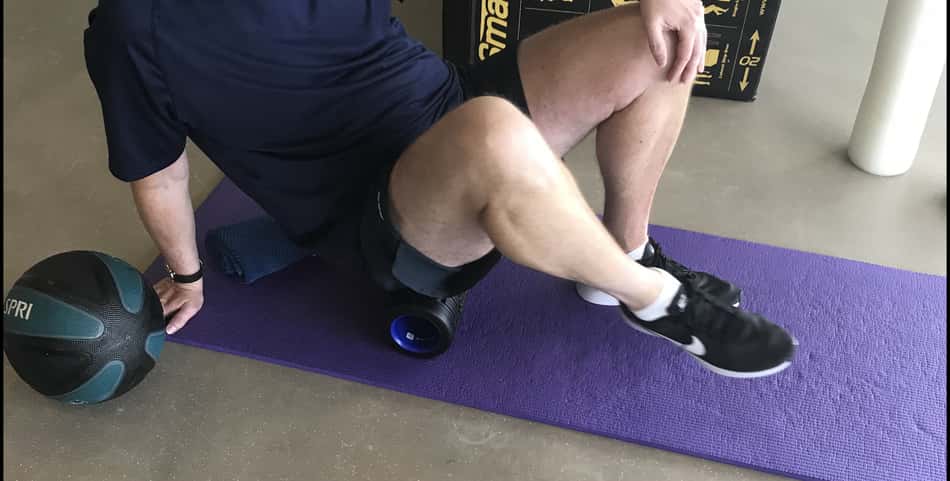
If you like to use a foam roller on your glutes, you will fall in love with a medicine ball. This is my favorite alternative method to mobilize, but it is only suitable for specific muscle groups like quads, glutes, and IT bands. The typical medicine ball is heavy-ish and is made of tough rubber.
Because of the ball shape, the pressure point is much more local than a regular foam roller. This allows you for better access to those soft tissues, also like someone would place an elbow on your tight.
The pressure will be harder, but you can get your tissues squeaky clean. I've used that with many of my clients, but only with the people who were already familiar with foam rolling.
Tips for rolling with medicine ball
- Spread your legs wide so you can have a better balance.
- Use your arms to support and position your weight in a way that the majority of your weight lays on the medicine ball.
- Comparing to a roller, a medicine ball can roll in multiple directions so it will take a minute or two for you to control, find the balance, and the right stability.
- To get the best results, spend more time in one spot instead of rolling back and forth.
- Once you feel comfortable, use contract-relax and flex-extend methods.
Get a massage ball
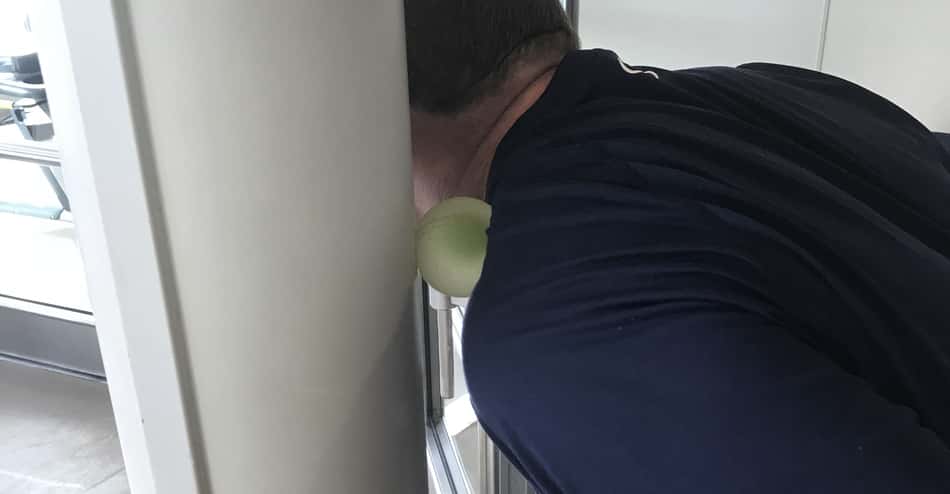
A simple yet powerful tool that you can use as a foam roller and take everywhere with you. A small massage ball comes in all shapes and sizes. Some of them are quite robust and offer more than just the massage.
My favorite one is the T spheres one from Amazon. This bad boy not only comes in different sizes but it also can be used hot or cold. This means you can literally place it in the microwave for few seconds to generate the heat.
Or you can keep it for the night in the freezer to make it ice cold. Depending on your goals, if you want to heat it up, it will penetrate to the muscle are much faster and deeper. If you cool it down, it can release some pain and relax your neck, shoulders, or temple area.
Tips for rolling with massage ball
- It can be used for all types of muscles, especially those that the large foam roller cannot get.
- Best for local pressure and contract-relax techniques
Ask your friend, colleague, or spouse
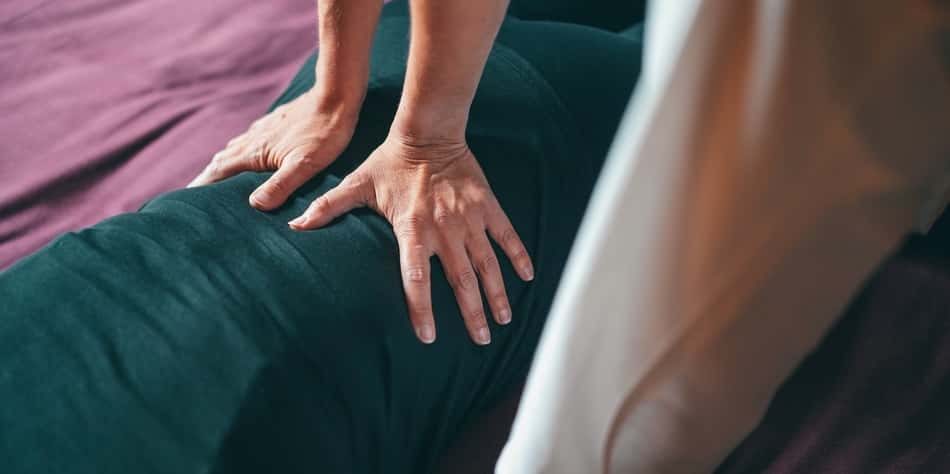
If you've ever had a Thai massage or Shiatsu massage then you probably saw at some point a therapist stepping on you and carefully applied the pressure using her foot. Walking on people is a regular part of a massage technique and can be used to work on specific muscle groups.
In fact, it is a part of Chinese weightlifters or Thai kickboxer's routine to walk on each other after the hard training session. So you don't need a specific skill or certification to be able to apply gentle pressure on a friend's quads or vice versa. You just need to be mindful of what you're doing.
Tips for manual pressure
- Ask your friend or spouse to take off their shoes. You don't want someone to step on your with their shoes on.
- Find a place where they can hold to a wall, fence, bench, or something that is stable enough to maintain balance.
- Lay down on the floor. You can place a yoga mat or a towel underneath. You don't want to be laying on the bed because the mattresses can be unstable.
- Depending on your weight, and the amount of pressure you can handle, ask them to either fully step on you or just apply the pressure with one foot at a time.
- Is better to use balls of the foot (front part of the door) because we have better motor control in that area.
- Clearly communicate with your friend what you're doing.
- Use a simple scale of 1 to 10 to describe how much pressure you feel right now.
- If you're not fully confident with someone stepping on you, ask them to use their elbows, forearms, or knees.
Double lacrosse ball, duoball or peanut ball

Another alternative for foam roller is using a double lacrosse, duoball, or "peanut" ball. This type of ball is designed for a very specific use. To roll on your spine. The shape looks like a peanut, with wider ends and narrow in the middle.
However, you can also use the duoball as a way to mobilize almost every muscle in the body. Because it is small, you can literally roll on your calves, quads, hamstrings, hip flexors, lower back, upper back, neck, and shoulders.
Tips for rolling with the Peanut ball
- With such a small diameter, you can expect to feel much more pressure than from the foam roller
- When you're rolling on your back, do not roll back and forth. Instead, stay on one spot and breathe. Spend 20-30 seconds and move up, one inch at a time.
- On your back, start from the lumbar position and one inch to move up towards the neck.
- When you roll your legs, you can roll back and forth, but the best results you get from staying on one specific area.
- Look for the spots that feel like something is not right there, and spend some quality time doing contract-relax and flex-extend until it feels better
- For the shoulders and chest, position yourself against the wall and just let the body lay on the ball.
- Lower yourself down and step away from the wall so you can shift your weight more on the ball.
Find a small 1-2 lbs dumbbell
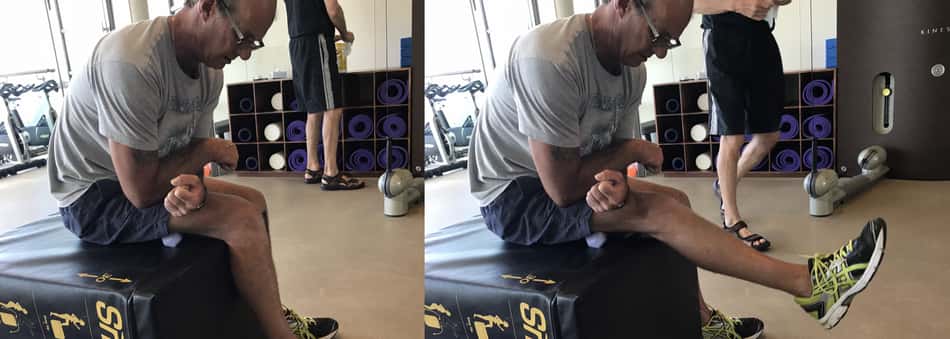
When I worked in the busy gym the most annoying thing was that at the peak times all the equipment was taken, including the foam rollers. That's when you need to get creative. And one of my innovations was to use a small 1-2lbs dumbbell as an alternative to the peanut ball.
A small dumbbell is usually coated with rubber and is slightly wider than your fist. This makes it the perfect size for a small and handy roller tool. However, it is only a good fit for some muscles.
The best way to use a small dumbbell is to mobilize your hamstrings, fore arms and hip flexors (if you have some courage). I see people having lots of troubles in mobilizing the hamstrings. That happens because its difficult to apply enough weight to really feel the benefits.
Here's how you do it with a small dumbbell.
Tips
- Find a chair, bench, or ideally a box
- Sit down on the box with your knees bent at 90 degrees and lower legs hanging.
- Place the dumbbell under your hamstring. Use one leg at a time.
- Find the spot on your muscle that you believe feels tight (it may feel slight discomfort)
- Once you find the spot, instead of rolling on it, simply shift your weight on the dumbbell, place your hands on the leg, and apply as much pressure as you can.
- Now once your weight is shifted on the side where you have the dumbbell, start to swing your leg slowly. Flex and extend.
- As you move your leg up and down (the leg that you have a dumbbell underneath) you will notice how the pressure feels so you can control it and change if necessary.
- Spend around 2 minutes per leg.
Use PVS pipe or a vacuum pipe
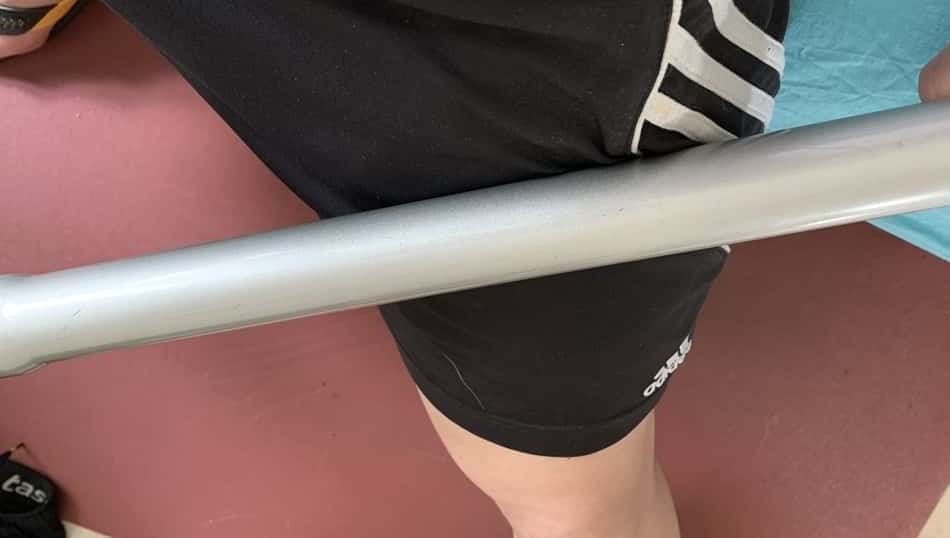
If you have no foam roller, but it happens that you have a spare PVS pipe, then you can easily go ahead a roll-on that. Similar to the dough roller, the PVS pipe has a small diameter and can create more localized pressure, which will result in better access to the tissue.
Depending on the length of the PVS pipe, the best areas to focus on your glutes, quads, calves, and arms. Because the pipe is flat, you don't want to use that on your lower back or the upper back.
If you have an old vacuum that you don't use, and you don't have an access to the foam roller. If you don't have what you like, you have to like what you have.
There are two types of vacuum pipes. One is made of soft material that flexes and bends in multiple ways. Another one is stiff and solid. Use that stiff one.
The vacuum pipe has a relatively small diameter (similar to the massage sticks) so you can use it to either foam roll on it or use that as a rolling tool to apply pressure on yourself, or someone else who you're helping.
Tips for rolling with the PVS pipe
- Make sure the PVS pipe has no defects or sharp edges that can cut your skin
Tips for rolling with vacuum pipe
- Vacuum pipe can be used to mobilize mainly the legs, glutes, and arms.
- Because of the small diameter, instead of rolling up and down apply PNF contract-relax technique.
Related article: How Often Should You Foam Roll?
Conclusion
As you can see there are several ways to skin the cat. Which makes it more accessible than ever before. And with enough creativity, you see that you don't have to go to the gym for a designated mobility or foam rolling routine.
You can do it easily at home with some of the most basic tools. And even if you don't have the best equipment, it doesn't matter because they all work.
What Can I Use to Roll Out My Muscles
Source: https://millennialhawk.com/how-to-roll-out-sore-muscles-without-a-roller/








0 Response to "What Can I Use to Roll Out My Muscles"
Post a Comment